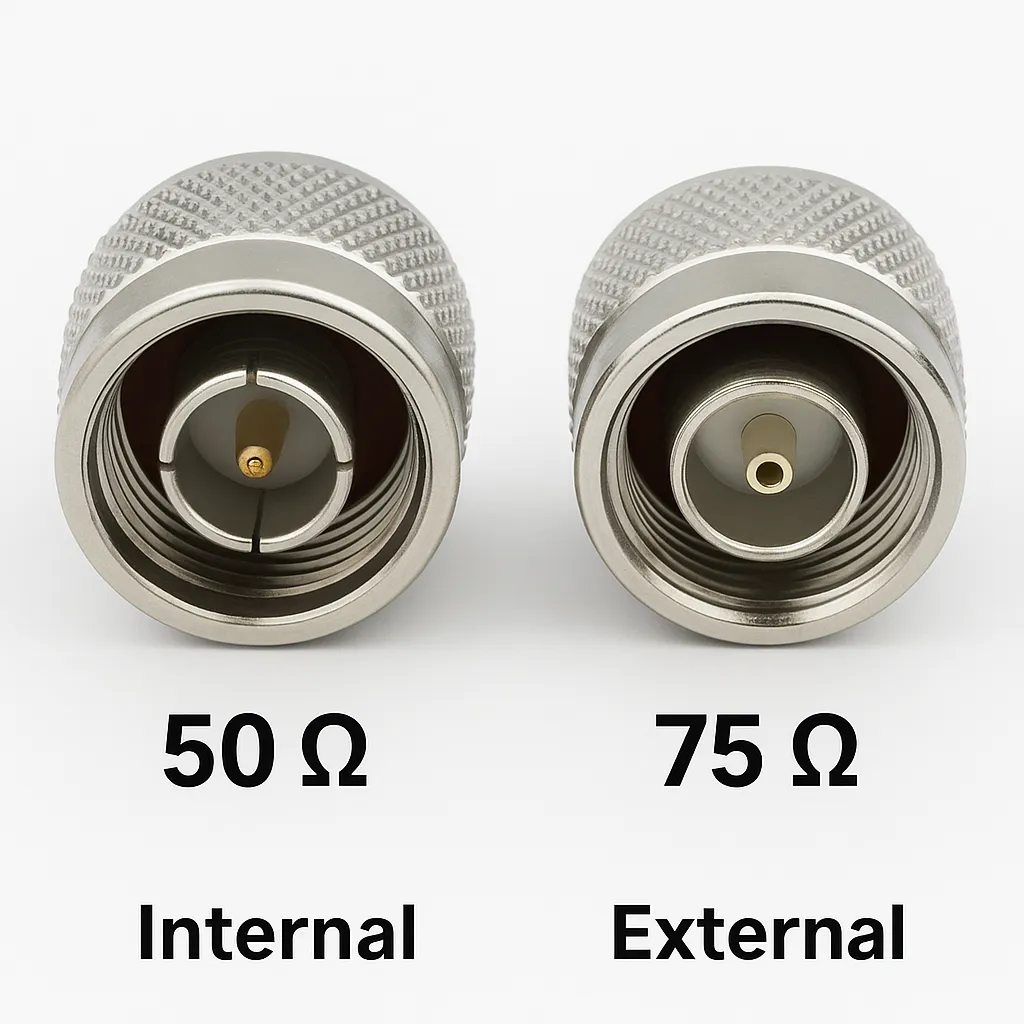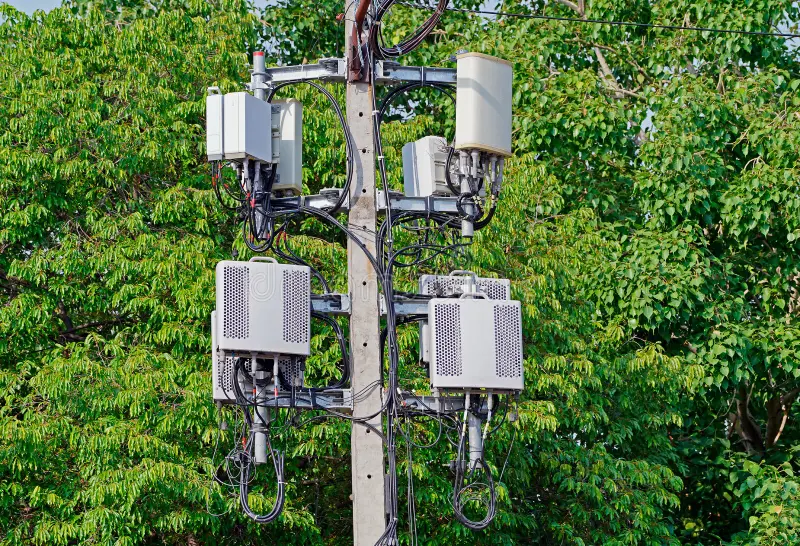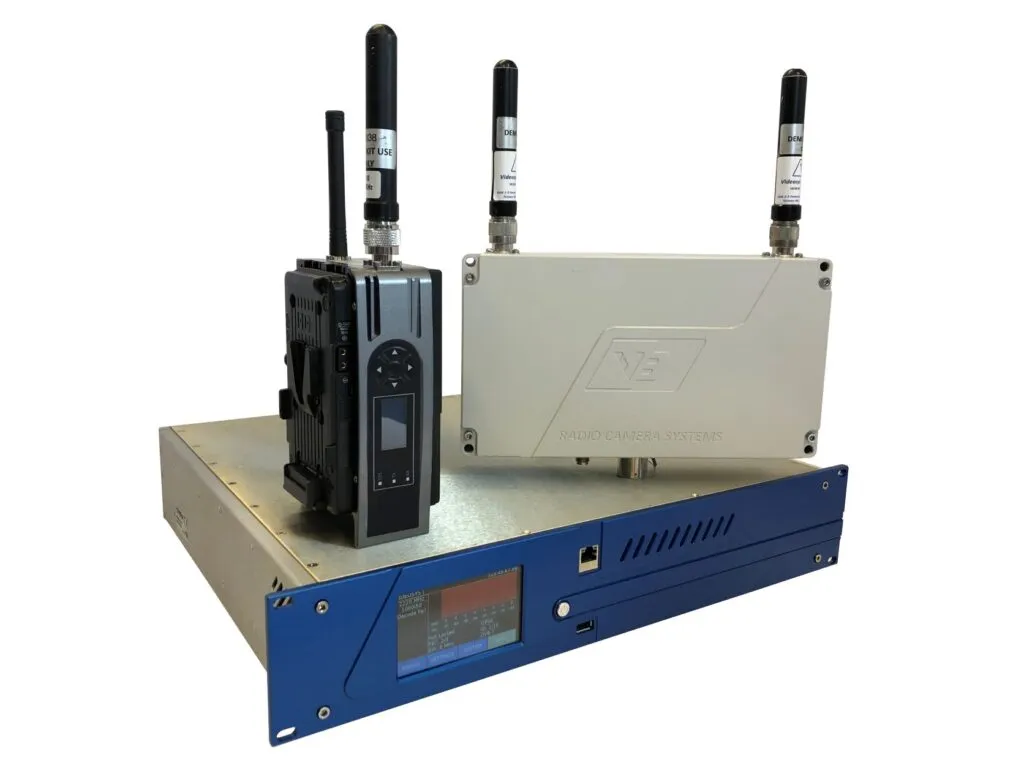N-Type to SMA Adapter Guide: Types & Waterproof Use
Sep 03,2025
Introduction

This image depicts a common real-world scenario for N-Type to SMA adapters, often used to connect large outdoor N-Type antenna feeds to smaller SMA ports on access points, test equipment, or telecom racks located indoors or in protected enclosures.
In RF engineering, few transitions are as common as N-Type to SMA adapters. Whether it’s connecting an outdoor antenna to an indoor access point, bridging equipment inside a telecom cabinet, or maintaining radio systems, these adapters keep projects moving without requiring new cable runs.
It’s important to clarify what these devices do: an N↔SMA adapter is not a protocol converter—you won’t be changing Ethernet or HDMI signals. Instead, it’s about achieving a proper coaxial interface match. Get the gender wrong, or mismatch the impedance, and you’ll be stuck with unusable gear.
This guide walks you through the fundamentals: what an N↔SMA adapter is, how to identify gender and contact type, the most common plug/jack combinations, and when to opt for bulkhead or waterproof designs. We’ll also highlight real-world TEJTE adapter specs (50 Ω, DC–18 GHz, VSWR ≤1.2, durability >500 cycles, -45 °C to +165 °C) so you know what performance looks like in practice.
1) What Is an N↔SMA Adapter?
At its core, an N-Type to SMA adapter provides a detachable coaxial interface between two of the most widely used RF connector families.
- N-Type connectors are large, threaded interfaces designed for outdoor and higher-power links.
- SMA connectors are smaller, threaded interfaces built for compact RF modules, IoT boards, and high-frequency test equipment.
An adapter bridges these two worlds. For example:
- A rooftop N-Type antenna feeding into an indoor SMA test instrument.
- A telecom rack where SMA jumpers connect to N-Type bulkhead connectors.
- A base station maintenance setup requiring temporary N↔SMA coupling.
It’s also worth distinguishing between a solid adapter and an adapter cable (pigtail). Solid adapters, like TEJTE’s N/SMA-JJ or N/SMA-KK models, are direct metal transitions. When flexibility is needed, an SMA adapter cable or even a UFL to SMA adapter can provide strain relief without sacrificing RF performance—something installers often appreciate in cramped enclosures.
Key spec snapshot (from TEJTE’s product line):
- Impedance: 50 Ω (standard RF transmission)
- Frequency range: DC–6 GHz (bulkhead waterproof types) to DC–18 GHz (precision test types)
- VSWR: ≤1.2:1 (low reflection, stable performance)
- Voltage rating: 1000 V
- Durability: >500 mating cycles
These figures set the baseline of what you should expect from a reliable N↔SMA adapter.
2) Identify Genders & Center Contacts (Avoid Buying the Wrong One)
SMA Basics
- SMA Male (plug): has external threads and a center pin.
- SMA Female (jack): has internal threads and a center receptacle (hole).
N-Type Basics
- N Male (plug): larger body, external threads, and a center pin.
- N Female (jack): internal threads with a center receptacle.
Quick Plug/Jack Reference
- Cable ends are usually referred to as plugs.
- Panel-mount or chassis ends are usually referred to as jacks.
In TEJTE’s catalog, you’ll see clear designations like:
- N/SMA-KK (female-to-female) for panel couplers.
- N/SMA-JJ (male-to-male) for direct bridging.
- N/SMA-KJ or JK (mixed male/female) depending on application.
These identifiers matter because if you mix them up, the adapter simply won’t mate. And forcing it? That risks damaging both the adapter and the expensive equipment it’s connected to.
General Specifications Table
| Parameter | Typical Value (TEJTE) | Notes & Benefits |
|---|---|---|
| Impedance | 50 Ω | Standard for RF transmission |
| Frequency Range | DC-6 GHz (waterproof flange) DC-18 GHz (precision) |
Covers LTE, Wi-Fi, 5G, GPS, microwave |
| VSWR | ≤1.2:1 | Low reflection, stable link |
| Voltage Rating | 1000 V | Handles lab & telecom loads |
| Durability | >500 mating cycles | Long service life in field use |
| Operating Temp. | -45 °C to +165 °C | Suitable for harsh outdoor installs |
| Material Options | Brass (nickel/gold plated), Stainless Steel | Trade-off between cost, conductivity, corrosion resistance |
| Insulator | PTFE / PEI | High stability under RF power |
3) Common Plug/Jack Combinations (Most Popular 6 Sets)
When selecting an N-Type to SMA adapter, most use cases fall into six common plug/jack pairings:
- N-male → SMA-female
- N-female → SMA-male
- N-male → SMA-male
- N-female → SMA-female (coupler)
- SMA-male → N-female
- SMA-female → N-male
These cover the majority of needs in labs, telecom racks, and antenna installations. For example, the N male to SMA female adapter is widely used in antenna connections, especially when bridging a large outdoor feed with a smaller device port.
TEJTE examples:
- N/SMA-KKF: 25×25 mm four-hole flange, rated 50 Ω, DC–6 GHz, VSWR ≤1.2, with waterproof sealing.
- N/SMA-KJ & N/SMA-JK: compact barrel adapters extending up to 18 GHz, durability >500 cycles.
- N/SMA-JJ (male-to-male): test bench setups, DC–18 GHz, -45 °C to +165 °C.
- N/SMA-KK (female-to-female): coupler type, also extending to 18 GHz in stainless steel versions.
- N/SMA-KWFK (right-angle waterproof flange): space-saving, IP-sealed.
Optional variants include right-angle forms (e.g., N/SMA-KWFK), which allow for space-saving installation, and extended-length bodies for thicker chassis walls. Whether you’re terminating inside a rack or building an outdoor feed, these small variations can prevent mechanical headaches.
To help you compare key specs across popular models, here’s a summary table:
| Model | Frequency Range | VSWR | Material & Finish | Application |
|---|---|---|---|---|
| N/SMA-J | DC–18 GHz | ≤1.2 | Brass, nickel/gold | Test benches |
| N/SMA-KK | DC–18 GHz | ≤1.2 | Stainless-steel option | Couplers |
| N/SMA-KKF | DC–6 GHz | ≤1.2 | Brass, waterproof O-ring | Outdoor panels |
| N/SMA-KWFK (RA) | DC–6 GHz | ≤1.2 | Brass, waterproof flange | Right-angle install |
4) 50 Ω vs 75 Ω: When It Matters

The image highlights the versatility of N-Type, balancing medium power, threaded durability, and dual 50/75Ω versions used across telecom and broadcast.
Both N-Type and SMA adapters are primarily designed for 50-ohm systems, covering RF data, cellular, GPS, and test equipment. But in some video surveillance and broadcast installations, you’ll still encounter 75-ohm N connectors.
So, what happens if you mix them?
- Short runs (a few centimeters): the mismatch may be tolerable, though return loss increases.
- High-precision measurement or broadcast video standards: mixing 50 Ω with 75 Ω is not acceptable—it degrades VSWR and introduces reflections.
Most RF connectors are designed to 50 Ω, following IEC 61169 standard.TEJTE’s adapters are specified at VSWR ≤1.2:1, which ensures clean transmission when impedances are matched. For example:
- N/SMA-JJ and KJ models operate up to DC–18 GHz with stable 50-ohm matching.
- N/SMA-KKF waterproof adapters run at DC–6 GHz, suitable for antenna-to-radio transitions in outdoor setups.
If your application is CCTV coax (75 Ω), it’s better to source a dedicated 75-ohm adapter rather than mixing. This keeps insertion loss predictable and ensures compliance with standards like SMPTE for broadcast video.
5) Outdoor & Panel-Mount: Bulkhead, O-ring & Torque
When adapters are used outdoors or mounted through equipment panels, mechanical details make the difference between a reliable link and a rain-soaked failure.
- Bulkhead vs panel-mount: Bulkhead designs include a long threaded section with a nut and washer, perfect for mounting through cabinet walls. Panel-mount flange types (e.g., N/SMA-KKF or KWFK) use a four-hole square flange for secure fixing.
- Thread length & panel thickness: TEJTE’s N/SMA-KKF flange versions offer 25 mm square patterns with 4×Φ3.5 mm holes, ensuring compatibility with standard enclosures.
- Waterproofing: Models like N/SMA-KKF waterproof flange adapter and N/SMA-KWFK (right-angle waterproof flange) include silicone O-rings that compress under torque, achieving IP-level sealing.
- Materials & plating: Options range from brass with nickel plating (cost-effective), brass with gold plating (low contact resistance), to stainless steel for corrosion-heavy environments.
- Temperature range: Many TEJTE designs withstand -45 °C to +165 °C, making them suitable for both telecom towers and industrial machinery outdoors.
These are sometimes referred to in catalogs as an SMA panel mount connector, especially for four-hole flange versions.
Tip: always apply the correct torque spec when tightening bulkhead nuts. Over-torqueing can crush O-rings and under-torqueing risks water ingress.
6) RF Considerations: Frequency, Power, VSWR & Loss
When you’re working with high-frequency or high-power RF systems, adapters aren’t just mechanical accessories—they directly impact signal performance.
- Frequency range: TEJTE’s precision N/SMA adapters support up to DC–18 GHz, making them suitable for microwave, radar, and 5G test setups. Waterproof flange versions are typically rated DC–6 GHz, which is plenty for outdoor LTE or Wi-Fi bands.
- VSWR: All TEJTE adapters specify ≤1.2:1, ensuring low reflection and minimal standing wave issues across the rated bandwidth.
- Power handling: While datasheets emphasize impedance and VSWR, real-world limits come from connector heating and dielectric breakdown. Models rated at 1000 V withstand voltage can manage significant RF power, though for sustained high-wattage transmissions, a short coaxial jumper is often preferred.
- Right-angle vs straight: Right-angle flange versions (e.g., N/SMA-KWFK) are mechanically convenient but can introduce slightly higher insertion loss above several GHz. For lab-grade accuracy, stick to straight adapters.
Precision adapters used in labs often comply with IEEE 287 coaxial connector standard.
Rule of thumb: minimize the number of metal-to-metal transitions. If you need to chain more than two adapters, it’s usually better to switch to a low-loss short cable assembly (RG316, RG178) instead.
7) When to Use a Cable Instead (Pigtails)
Solid adapters are compact, but they’re not always the best choice. In scenarios where stress or alignment is an issue, a pigtail cable offers clear advantages.
- Mechanical stress relief: A rigid adapter between a heavy N-Type antenna and a small SMA port can strain the PCB. A flexible RG316 jumper absorbs the stress.
- Tight enclosures: Mini IoT boards with U.FL or IPEX ports often can’t handle the bulk of an N connector. In this case, a U.FL to SMA pigtail (50 Ω, low-loss micro coax) is the right tool.
- Vibration isolation: In automotive or industrial equipment, cables provide vibration damping that rigid adapters can’t.
TEJTE’s catalog covers both solid and cable-based solutions. For instance:
- N/SMA-JK (SMA female to N male, DC–18 GHz) works well on test benches.
- But if mounted inside a cabinet with limited clearance, switching to a 10–20 cm RG316 pigtail with SMA bulkhead connectors prevents long-term wear.
The guiding principle: if you need flexibility, go with adapter cables. If you need compact rigidity, choose solid adapters.
8) Buying Checklist
To avoid costly mistakes and repeated orders, here’s a simple flow when selecting an N↔SMA adapter:
- Identify interfaces: Is your device N-male, N-female, SMA-male, or SMA-female?
- Direction & combination: Pick the exact pair (e.g., N-female → SMA-male).
- Impedance: Stick to 50 Ω for RF. Don’t mix with 75 Ω unless in short CCTV runs.
- Form factor: Straight, right-angle, or bulkhead flange mount.
- Environment: For outdoor use, select waterproof models with O-rings, like N/SMA-KKF waterproof flange adapter.
- Material & plating: Choose brass with nickel/gold plating for most uses; stainless steel for corrosive or high-durability applications.
- Durability: Look for >500 mating cycles (all TEJTE precision adapters meet this baseline).
- Temperature range: Ensure compatibility with your environment. TEJTE’s range of -45 °C to +165 °C covers both arctic winters and hot telecom enclosures.
Pro tip: Keep a small adapter kit in your lab or field toolbox. Stock the six common N↔SMA pairs, plus a few couplers. This avoids downtime when you’re on-site and can’t afford to wait for shipping.
9) Real-World Applications
While specs are important, the real question is: where do you actually use an N↔SMA adapter? Here are some of the most common scenarios:

This image demonstrates the installation of a specialized waterproof N-Type to SMA flange adapter on an outdoor access point or LTE gateway enclosure. It highlights the use of a sealed design with an O-ring to prevent moisture ingress, which is critical for reliable operation in harsh outdoor environments.
- Outdoor Wi-Fi & LTE access points
An N-Type bulkhead antenna mounted on a rooftop cabinet often needs to connect to an SMA port on a wireless AP. TEJTE’s N/SMA-KKF waterproof flange adapter is designed for exactly this.

This image covers two key applications: Left side shows a precision N-Type to SMA adapter (e.g., N/SMA-JJ) being used on a test bench for high-frequency 5G signal validation. Right side shows an industrial IoT cabinet where a flexible RG316 pigtail with an SMA bulkhead is used to provide strain relief and vibration isolation between a chassis-mounted N connector and an internal SMA device.
- 5G small-cell base stations
Lab and field engineers frequently use N/SMA-JJ precision adapters (DC–18 GHz) when validating high-frequency links or test instruments.
- Industrial IoT cabinets
When vibration and stress are concerns, a 10–20 cm RG316 pigtail (with SMA bulkhead) provides strain relief between N connectors on enclosures and SMA devices inside.
- Aerospace and defense equipment
For environments requiring corrosion resistance and durability, stainless steel N/SMA-KK or JJ adapters are preferred.

This image focuses on the application within broadcast and video surveillance systems, where 75-ohm impedance is standard. It shows a 75-ohm N-Type connector interface, emphasizing the importance of using impedance-matched adapters (75-ohm) in these scenarios to avoid signal degradation and reflections, unlike the standard 50-ohm adapters used in typical RF applications.
- Broadcast & surveillance systems
Although 50 Ω is standard, some legacy CCTV setups still use 75 Ω. Here, it’s critical to select matching impedance adapters or use dedicated 75-ohm versions.
10) FAQs
Q1: What is an N-Type to SMA adapter?
An N↔SMA adapter is a coaxial connector transition that allows a large N-Type interface to connect with a smaller SMA interface. For example, TEJTE’s N/SMA-JJ connects SMA-male to N-male, bridging lab equipment with outdoor antenna systems. Unlike digital converters (HDMI, Ethernet), it simply adapts the mechanical and electrical interface, keeping the RF signal intact.
Q2: Will N↔SMA adapters affect signal at high frequencies?
Yes, but minimally if designed correctly. High-quality adapters, like TEJTE’s DC–18 GHz precision series (N/SMA-JK, N/SMA-KJ), specify VSWR ≤1.2, ensuring low reflection and stable performance up through microwave bands. At these ranges, the rule is simple: fewer adapters equal cleaner signals. For outdoor applications capped at 6 GHz, waterproof flange models such as N/SMA-KKF waterproof flange adapter keep insertion loss well within acceptable limits.
Q3: How do I choose bulkhead thread length for my panel?
Panel thickness determines the required bulkhead thread length. TEJTE’s N/SMA-KKF flange adapters come in 25 × 25 mm patterns with 4×Φ3.5 mm holes, compatible with most telecom and equipment enclosures. If you’re working with thicker cabinets, an extended bulkhead version ensures the nut and washer can still secure firmly without over-compressing the O-ring.
Q4: When should I use a pigtail instead of a metal adapter?
Rigid adapters like N/SMA-JJ are great for bench setups. But when mechanical strain is an issue—such as a heavy N-Type antenna mounted directly on a small SMA port—a short RG316 pigtail is safer. It relieves stress, reduces vibration, and extends the lifespan of both connectors.
Q5: Is 75 Ω mixing acceptable in my setup?
It depends. For short indoor runs (a few centimeters), the mismatch might be tolerable. But in precision RF measurement or broadcast video applications, mixing 50 Ω and 75 Ω is unacceptable. TEJTE only specifies its N/SMA adapters at 50 Ω, covering wireless, GPS, test, and telecom systems. If your system is strictly 75 Ω (like CCTV coax), use a dedicated 75-ohm adapter to avoid reflections.
For more on impedance matching in RF systems, see ARRL’s technical resources.
Conclusion
N↔SMA adapters are small but vital components in RF work. Whether you’re connecting an outdoor antenna, maintaining a telecom rack, or testing a GPS module, the same principles apply:
- Check gender and direction first—don’t confuse plugs and jacks.
- Confirm impedance—50 Ω is standard; don’t casually mix with 75 Ω.
- Match structure to environment—use bulkhead or waterproof (like TEJTE’s N/SMA-KKF waterproof flange adapter) outdoors, and compact barrel adapters (like N/SMA-JK, KJ, JJ) indoors.
- Plan for RF performance—at frequencies up to 18 GHz, stick to precision adapters with VSWR ≤1.2; for high-power or stressed conditions, consider pigtails instead.
- Durability and materials matter—nickel-plated brass is economical, gold-plated options lower resistance, and stainless steel provides maximum corrosion resistance.
In short, whether you need a sma to n adapter for lab use or a waterproof flange model for outdoor deployment, matching specs to your environment ensures reliability. With the right choice, you’ll have a dependable, weatherproof, and low-loss transition between SMA and N-Type connectors.
Bonfon Office Building, Longgang District, Shenzhen City, Guangdong Province, China

A China-based OEM/ODM RF communications supplier
Table of Contents
Owning your OEM/ODM/Private Label for Electronic Devices andComponents is now easier than ever.
